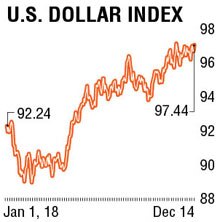
It has been another month of volatility with news flowing in from all fronts keeping investors fearful, confused and extremely cautious as they witnessed a see-saw movement in dollar-rupee. Although unexpected fluctuations in the rupee can be expected in a pre-election year, the recent moves has been perhaps a tad too abrupt for everyone to digest coming as it has on the back of a couple of years of low volatility and extreme stability in rupee. The bigger lesson to be learnt here is that - complacency can kill as the market can turn tides anytime and disciplined risk management is a must to avoid bloodshed (read protecting benchmark costs is key).
Both global and domestic events have taken a toll on the rupee in the recent past and unfolding them sequentially will provide us with fair bit of clarity in determining the key factors affecting rupee movement and associated vulnerabilities. It kicked off with Crude prices correcting by more than 30% since the start of November 18 which supported rupee in recouping its losses from 74.46 to 69.56 levels; an appreciation of 6.5%. Market participants breathed a sigh of relief anticipating the worst was probably behind.
This sweet spot lasted for only a fortnight as markets started discounting the outcome of the state elections, supply cuts in crude oil, the US-China trade tussle and Brexit uncertainty, prompting rupee to bounce back from 69.50 levels to 72 levels. On December 7, 2018, Opec and non-Opec allies went ahead with a production cut of 1.2 million barrels per day against market expectation of 1 million barrels per day resulting in crude bouncing back by 3%. Additionally the positive sentiment from a recent 90 days truce between US-China started waning with strong corrections seen across global equity markets.
 The British pound also lost ground against the US dollar and fell to 1.2480 levels after a report that colleagues of Prime Minister, Theresa May, believed they had sufficient numbers to mount a no-confidence vote to her leadership. This week the pound has weakened further with May's decision to delay a parliamentary vote on Brexit. News of the arrest of senior executive of Huawei Technologies was another negative headline that threatened to chill the US-China trade talks. Trump though has indicated that talks with China are going well and he could intervene in Huawei CFO case if it helps to resolve the trade issues.
The British pound also lost ground against the US dollar and fell to 1.2480 levels after a report that colleagues of Prime Minister, Theresa May, believed they had sufficient numbers to mount a no-confidence vote to her leadership. This week the pound has weakened further with May's decision to delay a parliamentary vote on Brexit. News of the arrest of senior executive of Huawei Technologies was another negative headline that threatened to chill the US-China trade talks. Trump though has indicated that talks with China are going well and he could intervene in Huawei CFO case if it helps to resolve the trade issues.
In India the Reserve Bank of India (RBI) governor Urjit Patel resigned with immediate effect on Monday, raising concerns over the autonomy of the central bank. The bigger question was - whether Patel resigned due to mounting pressure from government to lower rates and conduct loose monetary policy as he was reportedly criticised by the government over India's banking sector issues. Obviously, this news will not be taken positively by foreign investors and rating agencies until confidence is again restored by the new RBI governor.
Finance commission member Shaktikanta Das will succeed Urjit Patel as RBI governor for a period of three years. As the economic affairs secretary 2015 and 2017, Das spearheaded government's demonetisation drive and was instrumental in rolling out the government's Goods and Services Tax (GST) reform and is believed to be close to PM Narendra Modi. On the face of it, this would probably help to bridge the gap between government and RBI. However, the poor showing by the ruling party in the recent state elections opens up the possibility of the opposition uniting under the Congress umbrella again for the general elections in May 2019.
To wrap things up, we expect rupee to remain highly volatile till June 2019 on the back of slowing growth, Brexit uncertainty, RBI's stance on resolving banking issues and upcoming general elections. In the near-term, the rupee may take support between 70.50-71.00 levels and edge higher towards 73.50 levels.
The writer AVP - forex risk consulting with Mecklai Financial